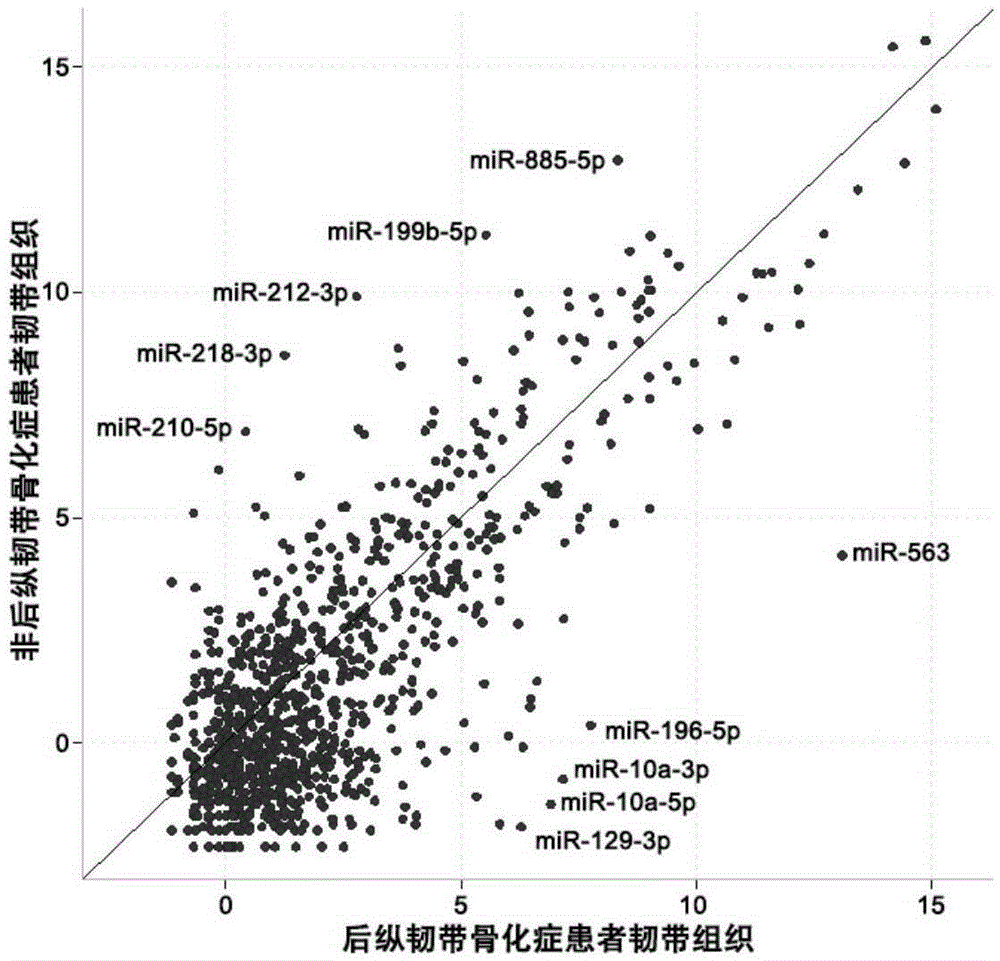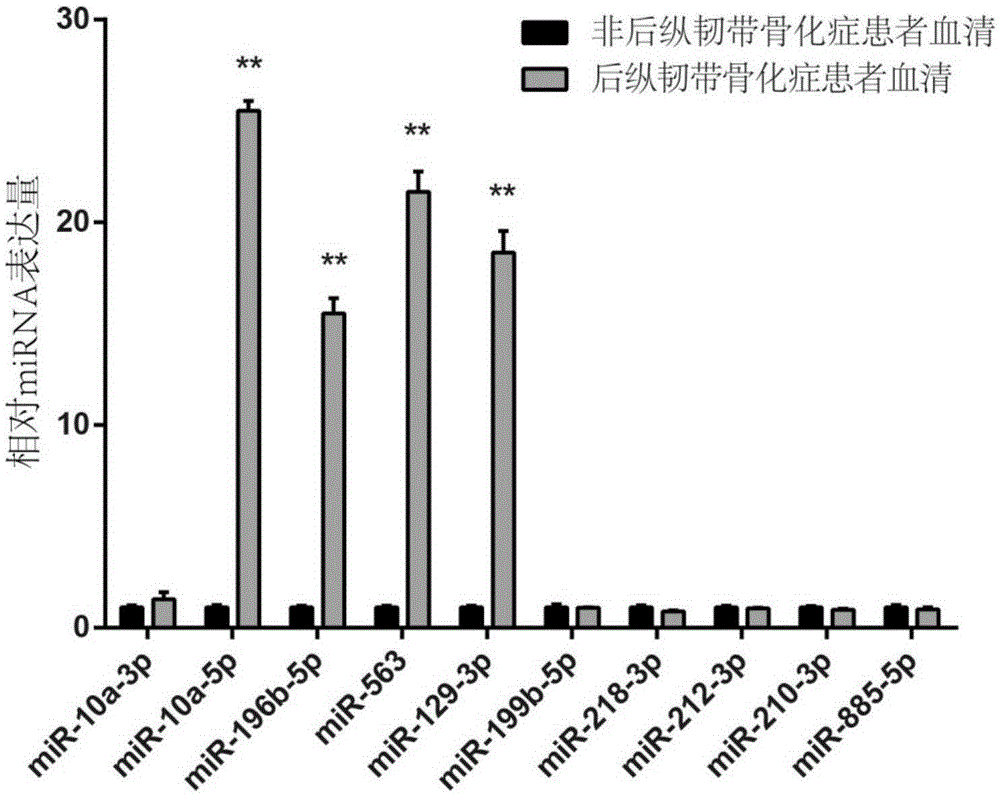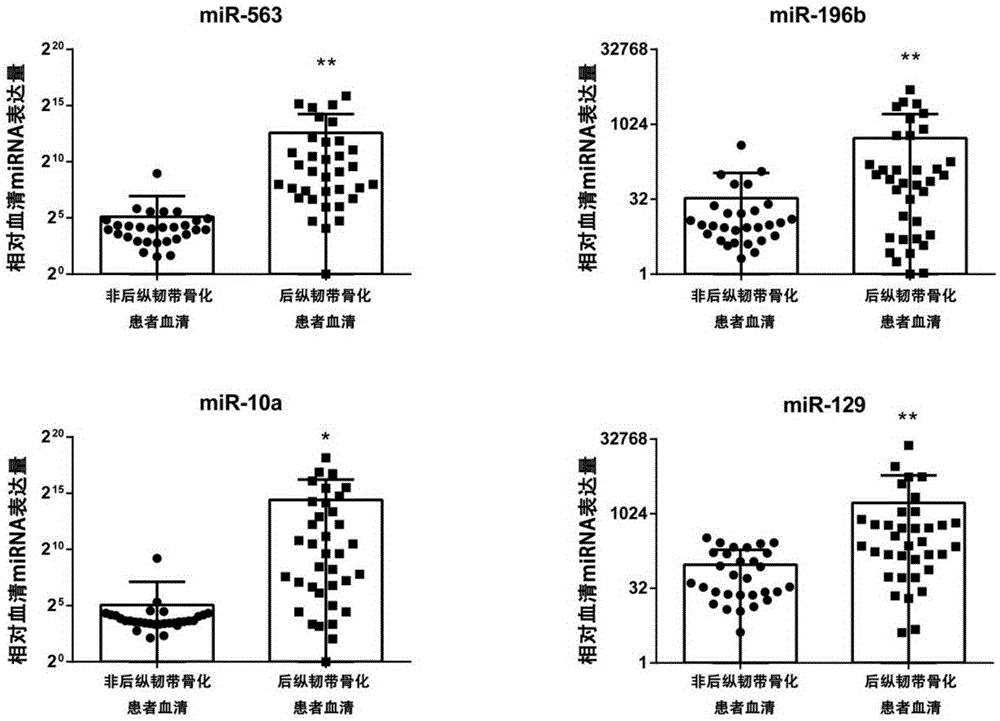Serum miRNA markers suitable for diagnosis of ossification of posterior longitudinal ligament and application thereof
A technology of posterior longitudinal ligament and diagnostic reagent, which is applied in the field of medical biological detection to achieve the effect of convenient and easy early screening and improve clinical treatment effect
- Summary
- Abstract
- Description
- Claims
- Application Information
AI Technical Summary
Problems solved by technology
Method used
Image
Examples
Embodiment 1
[0037] 1. Research object
[0038] The posterior longitudinal ligament tissues (n=3) of patients with ossification of the posterior longitudinal ligament (n=3) and the normal posterior longitudinal ligament tissues (n=3) during trauma surgery were selected for high-throughput sequencing and bioinformatics analysis of the miRNA group. There was no statistically significant difference between the case group and the control group in age, smoking, drinking and other factors (P>0.05).
[0039] 2. Research Methods
[0040] 1. Select the patient's ligament tissue during the operation, and immediately transfer it to RNAlater (Ambion company or other equivalent products) for short-term storage at low temperature. Freeze at -80°C immediately after transport to the laboratory.
[0041] 2. After all the samples are collected, the preserved tissue samples will be handed over to the company (high-throughput sequencing companies such as Libing Information, Bohao Biology, etc.) for high-thr...
Embodiment 2
[0048] Example 2: Serum OPLL-specific miRNA screening for admitted patients
[0049] 1. Research object
[0050] The case group consisted of 36 cases collected in Shanghai Changzheng Hospital from June 2015 to September 2015, all of whom were diagnosed with ossification of the posterior longitudinal ligament by CT three-dimensional reconstruction of the cervical or thoracic spine, without any treatment before blood collection. The control group consisted of 30 healthy individuals undergoing community disease screening during the same period, and all samples were informed of the purpose of collection and consented to by the patients before collection. There was no statistically significant difference between the case group and the control group in age, smoking, drinking and other factors (P>0.05).
[0051] 2. Research Methods
[0052] 1. Get up in the morning on an empty stomach, use EDTA anticoagulant tube to collect 5ml of cubital venous blood, shake gently after blood coll...
Embodiment 3
[0081] Example 3: Screening patients for OPLL by detecting serum OPLL-specific miRNA
[0082] 1. Research object
[0083] The case group consisted of 68 cases of OPLL collected in the First Spine Department of Shanghai Changzheng Hospital from June 2015 to October 2015, all of whom were diagnosed with ossification of the posterior longitudinal ligament by three-dimensional reconstruction of cervical spine CT, without any treatment before blood collection. The control group consisted of 45 outpatients from the orthopedic department, and none of the 45 patients had obvious symptoms, signs or imaging findings of OPLL. The purpose of collection was informed and the consent of the patients was obtained before all samples were collected. There was no statistically significant difference between the case group and the control group in age, smoking, drinking and other factors (P>0.05).
[0084] 2. Research Methods
[0085] With embodiment 2.
[0086] In order to clarify the specif...
PUM
 Login to View More
Login to View More Abstract
Description
Claims
Application Information
 Login to View More
Login to View More - R&D
- Intellectual Property
- Life Sciences
- Materials
- Tech Scout
- Unparalleled Data Quality
- Higher Quality Content
- 60% Fewer Hallucinations
Browse by: Latest US Patents, China's latest patents, Technical Efficacy Thesaurus, Application Domain, Technology Topic, Popular Technical Reports.
© 2025 PatSnap. All rights reserved.Legal|Privacy policy|Modern Slavery Act Transparency Statement|Sitemap|About US| Contact US: help@patsnap.com



